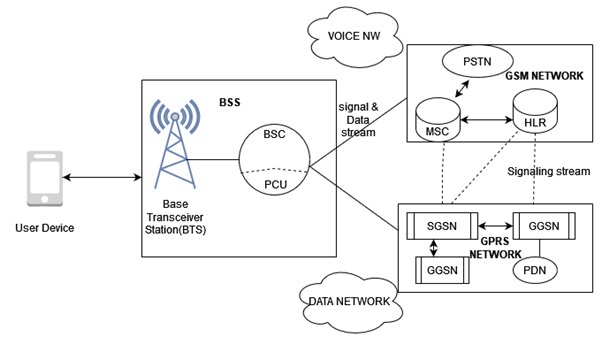
 Data Structure
Data Structure Networking
Networking RDBMS
RDBMS Operating System
Operating System Java
Java MS Excel
MS Excel iOS
iOS HTML
HTML CSS
CSS Android
Android Python
Python C Programming
C Programming C++
C++ C#
C# MongoDB
MongoDB MySQL
MySQL Javascript
Javascript PHP
PHP
- Selected Reading
- UPSC IAS Exams Notes
- Developer's Best Practices
- Questions and Answers
- Effective Resume Writing
- HR Interview Questions
- Computer Glossary
- Who is Who
GPRS architecture in wireless communication
Wireless Communication
Wireless communication is the process of sending voice and other forms of data without the installation of cables and wires. Radio communication systems are used at earlier stages of wireless transmitters, later then modulation is used within transmitters that use electromagnetic signals to send voice, data files, video, or other media signals over the network.
Wireless networks connect the network devices to a laptop, tablets, mobile phones, and other support devices to access the internet connection thereby eliminating the physical cabling of wires. After the invention of 4G standards in cellular networking, wireless applications are mostly by the users for speed and performance rate, but these factors may vary based on the network range supported by the devices. The evolution of wireless technology has reached its heights from a simple data transfer rate of 54 Mbps to many Gigabytes.
Two standards that support the cellular networks from the earlier version are GSM (Global System for Mobile Communications), CDMA (Code-Division Multiple Access), and later GPRS (General packet Radio Service) with the work architecture of GSM.
GPRS and GSM
General Packet Radio Service uses the architecture of GSM to transmit the data packets over the network with a data transport rate from 9.6 to 171 kbps and can allow multiple users to share the same interface at a single point in time. GSM systems do not provide easy access and performance when multiple users access the resources concurrently and this has made GPRS systems in action to provide packet-switched services with end-to-end support.
Enhanced security services are included in GPRS to ensure authentication and confidentiality and add a cipher algorithm during packet transmission. GSM uses a circuit-switched method to send the data packets with a data transfer rate of 14.4Kbps whereas GPRS uses packet-switched services with a data rate of 57. 6Kbps. Two additional entities are added with GSM architecture and new interfaces are defined for wireless communication purpose when 2G, 3G, or next-generation networks wants to send data along with other media information to handle the packet-switched data during the transmission process.
GPRS architecture
The new network elements added to the existing GSM architecture are the Serving GPRS Support Node (SGSN) Gateway GPRS supporting node (GGSN) and Packet Control unit (PCU).

SGSN
It works similarly to the Mobile Switching Center of the GSM network system. This extends its services listed below within a network, PCU determines the routing of the data either to be sent to the circuit or packet-switched networks. To create a data connection or call, GPRS needs to activate SGSN via the BS (Base Station) of the network area.
The size of the data unit transmitted over the channel can be reduced by implementing data compression methods.
When the connection is made to the external network the routing of the actual data is done by the SGSN node, which is then linked to the respective GGSN.
It provides authentication, security, and session management.
It supports mobility management, as users are connected wirelessly and move from one place to other which can change from one SGSN to another SGSN node.
Location register which is present within SGSN to store local information (visitor location) and user profile details for all the users who use the GPRS system registered with the specific SGSN.
Charging functions are included with Call Detailed Record (CDR) information which is needed by the network service providers to send invoice details to the customers.
Gateway functions support temporary storage and transport of the CDR data for billing systems.
Performance and maximum withhold capacity of SGSN are defined by parameters like the maximum number of users at a single point in time, maximum throughput, and the number of packet data control supported.
GGSN
It acts as an internetworking unit between GPRS and external data packet networks. It has routing information and routes the packet from the external IP to the respective SSGN with the same GPRS network. It also routes the packets from the user side to an external IP network address. It does address conversion and sends data to the destination address by encapsulation method. It acts as a traffic filter to control the data information, that is collected from external networks.
PCU
It is a piece of hardware connected to the BSC (Base Station Controller) either internally or near SGSN outside. It is used to separate between GSM and GPRS traffic systems, which is the core unit in GPRS architecture. It is used to classify the packet and circuit switched traffic from the user end and sends it to respective GSM and GPRS networks.
Network Upgradation
When new upgrades are needed by the network, then network operators will look for operational and expenditure costs. When the GPRS system must be deployed this may not incur more of a cost to buyers or network operators as it is an extended GSM architecture with few network nodes SGSN and GGSN added within the network.
Changes must be made to the Base station by including the PCU unit in each BSC node. Software used in BTS (Base Transceiver Station) needs to be upgraded and can be done remotely by the operators.
Conclusion
GPRS architecture supports circuit switches as well as packet services to transport the data through the network. When GPRS is used in wireless communication devices, the data transfer rate is efficiently higher than GSM as it supports multiple users to send and broadcast multimedia data concurrently.

